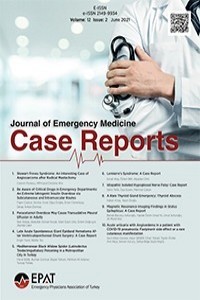Nöroleptik Malign Sendromda Atipik Antipsikotiklerin Rolü: İki Olgu Sunumu Ve Literatürün Gözden Geçirilmesi
Nöroleptik malign sendrom, bilinç değişikliği, acil servis
The Role of Atypical Antipsychotics in Neuroleptic Malignant Syndrome: Report of Two Cases and
___
- Paul M, Michael SG, John S, Lenox RJ. An atypical presentation of neuroleptic malignant syndrome: diagnostic dilemma in a critical care setting. Respir Care 2012; 57: 315-7.
- Ergin M, Cander B, Girişgin AS, Koçak S, Acar T, Gül M. A serious side effect of antipsychotic therapy: Neuroleptic malign syndrome. JAEMCR 2012; 3: 83-5. [CrossRef]
- Detweiler MB, Sullivan K, Sharma TR, Kim KY, Detweiler JG. Case reports of neuroleptic malignant syndrome in context of quetiapine use. Psychiatr Q 2013; doi: 10.1007/s11126-013-9264-4 [CrossRef]
- Gillman PK. Neuroleptic malignant syndrome: Mechanisms, interactions, and causality. Mov Disord 2010; 25: 1780-90. [CrossRef]
- Gortney JS, Fagan A, Kissack JC. Neuroleptic malignant syndrome secondary to quetiapine. Ann Pharmacother 2009; 43: 785-91. [CrossRef]
- Caroff SN. The neuroleptic malignant syndrome. J Clin Psychiatry 1980; 41: 79-83.
- Carroll BT, Surber SA. The problem of atypical neuroleptic malignant syndrome: a case report. Psychiatry (Edgmont) 2009; 6: 45-7.
- Caroff SN, Mann SC. Neuroleptic malignant syndrome. Med Clin North Am 1993; 77: 185-202.
- Levenson JL. Neuroleptic malignant syndrome. Am J Psychiatry 1985; 142: 1137-45.
- American Psychiatric Association: Diagnostic and Statistical Manual of Mental Disorders, 4. baskı. Washington DC, American Psychiatric Association, 2000, s. 795-8.
- Yayın Aralığı: 4
- Başlangıç: 2010
- Yayıncı: Alpay Azap
Gerçekten Diyabetik Ketoasidoz mu? Çifte Bela
Filiz Baloglu KAYA, Arif Alper ÇEVİK, Şeyhmus KAYA, Engin OZAKIN, Nurdan ACAR
Epileptik Bir Çocukta Amanita Virosa Alımı Sonrası Refrakter Status Epileptikus Oluşması
Çapan KONCA, Ali GÜNEŞ, Halil KOCAMAZ, Servet YEL, Mehmet BOŞNAK
Mehmet DOKUR, Gülşen Pancar GÜLMEZ, Samiye Uslu KUZUDİŞLİ
Seksüel Aktivite Sonrası Şiddetli Başağrısını Olgu Sunumu ile Gözden Geçirme
İlyas ERTOK, Gülhan Kurtoğlu ÇELİK, Yavuz OTAL, Erkut EROL, Pervin SARIKAYA, Şervan GÖKHAN
Halise AKÇA, Emine POLAT, Nilden TUYGUN, Neslihan Gürcan KAYA, Can Demir KARACAN
Mide Volvulusu ile Birlikte Mikst Hiatal Herni: Nadir Görülen Bir Akut Karın Tablosu
Hüseyin PÜLAT, Oktay KARAKÖSE, Mehmet Fatih BENZİN, Şeyma BENZİN, Tevfik BÜLBÜL, Mahmut BÜLBÜL
Kardiyopulmoner Resüsitasyonun Nadir Bir Komplikasyonu: Karaciğer Yaralanması
Eyyüp YILMAZ, Mehmet ÖZBAY, Elif ÖMEROĞLU, Nezih ANOLAY, Hüseyin SARI, Mustafa İÇER
Erişkin Still Hastalığı: Olgu Sunumu
Ercan GÜNDÜZ, Mehmet Nezir GÜLLÜ, Yılmaz ZENGİN, Recep DURSUN, Mustafa İÇER, Ayhan ÖZHASENEKLER, Yenal KARAKOÇ, Murat ORAK
Servikal Boyunluk Kullanımıyla Tedavi Olan Hangman Fraktür; Olgu Sunumu
